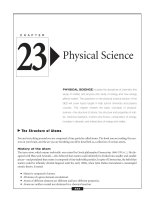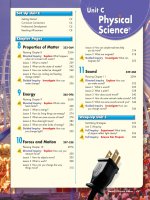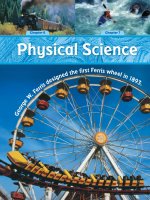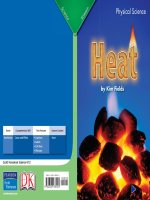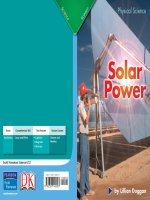4 13 poles apart (physical science)
Bạn đang xem bản rút gọn của tài liệu. Xem và tải ngay bản đầy đủ của tài liệu tại đây (4.58 MB, 14 trang )
Genre
Nonfiction
Comprehension Skill
Cause and Effect
Text Features
• Captions
• Labels
• Text Boxes
• Glossary
Science Content
Electricity and
Magnetism
Scott Foresman Science 4.13
ISBN 0-328-13897-5
ì<(sk$m)=bdijhf< +^-Ä-U-Ä-U
Vocabulary
Extended Vocabulary
electric current
electromagnet
magnetic field
magnetism
parallel circuit
resistance
series circuit
static electricity
aurora
foundry
maglev train
magnetic north
magnetite
magnetosphere
MRI
solar prominences
Picture Credits
Every effort has been made to secure permission and provide appropriate credit for photographic material.
The publisher deeply regrets any omission and pledges to correct errors called to its attention in subsequent editions.
Photo locators denoted as follows: Top (T), Center (C), Bottom (B), Left (L), Right (R), Background (Bkgd).
7 (CR) James Leynse/Corbis; 12 Per-Magnus Hedén/pixonnet.com/Alamy Images; 13 (TR) ©SOHO (ESA & NASA)/NASA;
16 profimedia/Alamy Images; 21 (CR) Rubberball Productions; 23 Lester Lefkowitz/Corbis.
Scott Foresman/Dorling Kindersley would also like to thank: Opener: Stephen Oliver/DK Images.
Unless otherwise acknowledged, all photographs are the copyright © of Dorling Kindersley, a division of Pearson.
ISBN: 0-328-13897-5
Copyright © Pearson Education, Inc. All Rights Reserved. Printed in the United States of America.
This publication is protected by Copyright, and permission should be obtained from the publisher prior to any
prohibited reproduction, storage in a retrieval system, or transmission in any form by any means, electronic,
mechanical, photocopying, recording, or likewise. For information regarding permission(s), write to
Permissions Department, Scott Foresman, 1900 East Lake Avenue, Glenview, Illinois 60025.
3 4 5 6 7 8 9 10 V010 13 12 11 10 09 08 07 06 05
What did you learn?
1. How does a maglev train use magnets
to move?
2. Where on Earth are you most likely to see
auroras in the sky?
3. Think about a room in your home.
Make a list of the things in that room
that use electricity.
4.
You have read
by Patricia Walsh
about electricity and magnetism in this
book. What do you think is the most
important tool we have that uses these
invisible forces? Why do you think so?
Include details from the book to support
your answer.
5.
Cause and Effect When you stroke a
bar of steel with a magnet, what causes
the bar to become magnetized? What
effect might this magnetized bar have
on other metal objects?
What You Already Know
Objects are made of tiny, electrically charged atoms.
The particles that make up atoms can have a positive
or negative charge, or no charge at all. Static electricity
comes from electrical charges moving between atoms.
This causes both powerful lightning and clinging socks.
An electrical force can develop between objects that
have opposite charges. The space around electrically
charged objects is an electric field.
When an electric charge is
in motion, it is an electric
current. An electric charge
does not move easily
through an insulator. It
moves more easily through
a conductor. A material
with resistance does not
allow an electric charge to
flow easily through it.
Most electricity flows through a circuit. A series
circuit has one path for the electric charge to follow.
Everything along this path receives the same amount of
energy. A parallel circuit has two or more paths. It can
handle devices that need different amounts of current.
Magnetism is the force that pushes or pulls
magnetic materials near a magnet.
A magnet has an invisible magnetic field
around it. This field is strongest at the
magnet’s poles. Earth is similar to a huge
magnet, with a magnetic field and poles.
The needle of a compass points to Earth’s
magnetic north pole.
An electromagnet is a coil of wire
wrapped around an iron core. It transforms
electrical energy into magnetic energy.
We can find electromagnets in many
objects we use every day. Magnetism
can also be used to make electricity.
horseshoe magnet
You can cause static
electricity by rubbing
balloons against your hair.
The balloons will then stick
to things.
Electricity and magnetism are related in many ways.
In this book we’ll take an in-depth look at the invisible
world of electricity and magnetism that surrounds us,
works for us, and makes our lives easier.
2
3
An Invisible Force
Magnetism is an invisible
force that is strongest at the poles,
or ends, of a magnet. A magnet is
surrounded by a magnetic field.
The paper clips in this picture
are made of metal. Metal objects
are often attracted to the poles of
a magnet. The magnetic field
around this magnet is powerful
enough to pull some of the paper
clips toward it.
The magnetic field of an object can be very strong.
Iron and steel objects placed within a magnetic field
will be pulled toward the magnet. The pattern made by
the iron filings shows the bar magnet’s magnetic field.
A compass needle points north. However, when
a magnet is placed near the compass, the magnet has a
strong pull on the needle. This makes the needle point
in the direction of the magnetic field.
The pattern of iron filings and
the compass needles show
the magnetic field of the bar
magnet.
The force of this magnet pulls
the paper clips to its poles.
4
5
Pushes and Pulls
The end of a bar magnet is either a north pole or a
south pole. When placed near each other, opposite
magnetic poles attract. This means they try to pull
together. If you turn one of the magnets around and
place the same magnetic poles together, such as two
south poles, they repel each other. This means they
push apart.
One use for this property of magnetism is maglev
trains. Maglev is short for magnetic levitation. Today
most trains roll on wheels along steel tracks. Maglev
trains use magnets to make the train float over a
magnetized track.
south
N
S
north
N
S
The south pole of one magnet
is drawn to the north pole of
another magnet. Opposite
poles attract.
6
Two south poles push away from
each other. Similar poles repel.
S
N
N
S
The maglev train makes
use of magnets and
electromagnets in
order to move.
Large magnets are
attached to the underside of
a maglev train. The magnets
on the track and the magnets
on the train repel each other.
This makes the train move above
the track. Electromagnets push and
pull the train along the track. Maglev trains have reached
speeds of more than 300 miles per hour. Scientists think
maglev trains could travel even faster.
The technology is ready, but it is still very expensive
to build a maglev transportation system. Do you think
one day you will step into a maglev train?
7
What makes a magnet?
Some stones found in Earth’s crust can attract iron.
These stones are natural magnets. They are pieces of
magnetite, or lodestone, a mineral rich in iron.
The magnets that you may put on your
refrigerator are probably not natural
magnets. Refrigerator magnets are usually
manufactured in a foundry, or a place where
metal is melted and molded into a shape. The
metal is then magnetized.
Magnetize a Steel Bar
Rubbing a magnet over a steel bar
organizes the magnetized areas
in the bar. Striking the bar mixes
those areas and weakens the
magnet.
Magnet strokes bar.
Magnetized areas
are mixed.
Magnet arranges
magnetized areas.
Magnetized areas
are mixed again.
Magnetite with iron filings
Magnets are being cast in a foundry.
8
The bar and horseshoe magnets used in
classroom experiments are also made in a
foundry. Manufactured magnets are similar
to natural magnets in that they contain iron,
cobalt, or nickel. These metals can be
magnetized. They are made up of tiny crystals
whose atoms line up in a regular order. Each
crystal acts as a tiny magnet with a north and
south pole.
A magnetized material, such as a steel bar,
is stronger when the north poles on all of the
crystals point in one direction and the south
poles all point in the opposite direction. When
this happens, there is just one north pole and
one south pole.
9
Magnetic Earth
North Pole
Earth is similar to a huge bar magnet.
Earth has a magnetic field, just as a bar
magnet has. This magnetic field covers
the area between Earth’s north and south
magnetic poles, just as it does between
South Pole
the poles of a bar magnet.
Earth has two kinds of poles. Earth’s magnetic poles
are different from its geographic poles. Geographic
north is the area in the Arctic Ocean called the North
Pole. The magnetic north and south poles are found
near the geographic North and South Poles.
Magnets can be used to make a compass. The needle
inside a compass is a small magnet, often made of steel.
The needle is attracted to Earth’s magnetic north. It swirls
around so it points in that direction.
Earth’s magnetic field attracts more than just compass
needles. It can also attract charged particles in space. The
area around Earth that is affected by Earth’s magnetic
field is called the magnetosphere. It extends far into space.
You can use
a compass
to help you
find a specific
direction.
How to Make a Compass
Rub a bar magnet over
a needle. Then float the
magnetized needle on a
piece of cork in water.
It will point north.
magnetizing a needle
10
needle on cork
floating in water
11
Magnetism in Space
Earth’s magnetism interacts with tiny charged
particles that come from the Sun. The positive and
negative particles in Earth’s magnetosphere collide with
gases in the atmosphere. The collisions cause an amazing
display of different colors of light. This display is called
an aurora. You are most likely to see auroras in the night
sky near Earth’s magnetic poles. This glowing light show
lasts from a few seconds to a few hours.
The Sun also has
a magnetic field. The
Sun has great
explosions of hot gas.
These explosions, or solar
prominences, erupt from the surface
of the Sun into its atmosphere. The
Sun’s magnetism pulls the gas back to
the surface, creating vast loops of
burning gas.
Other planets in the solar system also
have magnetic fields. Jupiter’s magnetic
field is about twenty thousand times
stronger than Earth’s. Uranus and
Neptune experience great changes in the
strength of their magnetic fields. Some
planets have weaker magnetic fields than
Earth. Venus is not magnetized.
Hot gas erupts
from the Sun
in a solar
prominence.
The Sun’s
magnetic field
pulls it back.
The aurora borealis
can be seen in parts
of the Northern
Hemisphere.
12
13
Electromagnetism
Electric and magnetic forces are used together to
produce electromagnetism. An electromagnet begins
with a power source, such as a battery or a generator.
Electric current can flow through a wire. This makes
a magnetic field around the wire. If you coil the wire,
you’ll make the magnetic field stronger. The more
turns in the coil, the stronger the magnetism.
To make an even stronger electromagnet, you
can wind the wire around an iron bar. Using
a larger iron bar will make the
electromagnet stronger.
An electromagnet is similar to a
bar magnet because it also has a
north and south pole. But unlike
a bar magnet, which is always
magnetic, an electromagnet is
a temporary magnet. The
magnetic field exists only when
electric current flows through
the wire. If the electric current
stops flowing, the magnetic
field disappears.
14
Electromagnets are so powerful that they can lift
and transport very heavy pieces of metal. That is why
electromagnets are valuable pieces of equipment at
construction sites and recycling centers. The electromagnet
is turned on to pick up pieces of metal. Once the pieces are
placed in their new location, the magnet is turned off.
The electromagnet
will drop the pieces of
metal when the electric
current stops flowing.
15
Generating Current
You now know that electricity and magnetism are
often used together. Just as electric currents can make
a magnetic field, magnets can be used to make electric
current. Magnetism plays an important part in powering
the appliances and lights in our homes. Most of our
electric power comes from large generators that may
be miles away.
In a generator, a coiled wire is surrounded by a
spinning magnet. When the magnet spins, it pushes
electric current through the coiled wire. A turbine keeps
the magnet moving. A turbine is a machine that has a
rotating wheel with paddles attached to it.
Steam, moving air, or moving water is
usually used to power the turbine.
The generator sends out current
that travels through wires, often
over many miles.
16
Generating Electricity
Moving a copper wire between the opposite
poles of two bar magnets generates a current.
A meter measures the amount of current.
copper wire
magnet
meter
Large generators send
power through wires.
17
Electric Motors
battery
This homemade
electric motor uses
bar magnets and a
wire coil. Its power
source is a battery.
Electric motors don’t stop there. A part of the
motor called the commutator reverses the magnetic
field of the electromagnet. Its north pole becomes its
south pole, and its south pole becomes its north pole.
When this happens, the poles of the bar magnets and
the electromagnet repel each other and are attracted
to the opposite poles. This makes the electromagnet
rotate. This movement makes machinery run.
You might be surprised to learn how many electric
motors power the things you see and use each day.
Elevators, refrigerators, vacuum cleaners, hair dryers,
and fans are some items that use electric motors.
electromagnet
commutator
bar magnet
Electric toy cars contain
electric motors.
An electric motor uses
magnets and electromagnets to
make motion. It has a wire coil
and permanent magnets, such as bar magnets, on each
side. One bar magnet has its north pole facing up, and
the other one has its south pole facing up. When
electricity from a power source flows into the wire
coil, it makes an electromagnet. The north pole of the
electromagnet is attracted to the south pole of the bar
magnet, and the south pole of the electromagnet is
attracted to the north pole of the bar magnet.
18
19
Using Electromagnets
You’ll find that electricity and magnetism have many
uses in our daily lives. We depend on electric power for
light at night, sounds from the radio, and cool air in the
summer. Electric power also cooks our food and keeps
it cold.
Electromagnets are used to make doorbells ring.
Current flows to a device that controls just how much
current reaches the electromagnet in the bell. Electricity
that is flowing in the coil of the wire
magnetizes the electromagnet.
This causes the hammer to
strike the bell, which makes
the sound we hear.
Electric guitars use electromagnets to make the sound
you hear. The strings on an electric guitar vibrate when
they are plucked. The guitar has magnetic pickups that
sense these vibrations electronically. A pickup is a bar
magnet with wire wrapped around it. An electric guitar
can have several pickups or just one.
The pickup sends the electronic
vibrations as an electronic signal to
a speaker. You hear the sound
from the guitar.
pickups
Hammer strikes bell.
electromagnet
Guitar pickups turn
sound vibrations
into electricity.
Bells use electromagnets
to make a ringing sound.
20
21
There are electromagnets in the motors in our cars
as well. The driver’s seat might be adjusted by as many
as seven electric motors. Power windows are run by an
electric motor. The windshield wipers and the starter
are just a few more places that you will find motors
with electromagnets.
Computers use electromagnets in order to store
information in memory. You can find electromagnets in
electric clocks, DVD players, CD players, and calculators.
Many battery-operated toys have electromagnets. Our
transportation also depends on electromagnets. Buses,
motorcycles, and airplanes cannot travel very far without
the help of electromagnets.
Electromagnets are used in our health care instruments.
An MRI machine uses powerful electromagnets to produce
images of the inside of a patient’s body. The patient lies
still while the machine takes pictures from many angles.
The letter M in MRI stands for “magnetic.”
Electromagnetic power can be found everywhere.
Can you imagine a world without it?
brain
Computers use
electromagnets.
spinal
column
22
23
Vocabulary
Glossary
electric current
electromagnet
magnetic field
aurora
magnetism
parallel circuit
resistance
foundry
series circuit
static electricity
Extended Vocabulary
aurora
foundry
maglev
train colors of light
a display
of different
magnetic
north
in Earth’s
magnetosphere
magnetite
a placemagnetosphere
where metal is melted
MRI
and made into a shape
solar prominences
maglev train
a high-speed train propelled
by electromagnetism
magnetic north
pole
the northernmost point of the
magnetic field that surrounds Earth
magnetite
iron ore that is magnetic
magnetosphere
an area around Earth affected
by Earth’s magnetic field
Picture Credits
Every effort has been made to secure permission and provide appropriate credit for photographic material.
The publisher deeply regrets any omission and pledges to correct errors called to its attention in subsequent editions.
MRI
magnetic resonance imaging,
7 (CR) James Leynse/Corbis; 12 Per-Magnus Hedén/pixonnet.com/Alamy
Images;to
13 (TR)
©SOHO (ESA & NASA)/NASA;
used by doctors
diagnose
16 profimedia/Alamy Images; 21 (CR) Rubberball Productions; 23 Lester Lefkowitz/Corbis.
illness or injury
Scott Foresman/Dorling Kindersley would also like to thank: Opener: Stephen Oliver/DK Images.
Photo locators denoted as follows: Top (T), Center (C), Bottom (B), Left (L), Right (R), Background (Bkgd).
Unless otherwise acknowledged, all photographs are the copyright © of Dorling Kindersley, a division of Pearson.
solar prominences
explosions of hot gas from the Sun
ISBN: 0-328-13897-5
Copyright © Pearson Education, Inc. All Rights Reserved. Printed in the United States of America.
This publication is protected by Copyright, and permission should be obtained from the publisher prior to any
prohibited reproduction, storage in a retrieval system, or transmission in any form by any means, electronic,
mechanical, photocopying, recording, or likewise. For information regarding permission(s), write to
Permissions Department, Scott Foresman, 1900 East Lake Avenue, Glenview, Illinois 60025.
3 4 5 6 7 8 9 10 V010 13 12 11 10 09 08 07 06 05
24
What did you learn?
1. How does a maglev train use magnets
to move?
2. Where on Earth are you most likely to see
auroras in the sky?
3. Think about a room in your home.
Make a list of the things in that room
that use electricity.
4.
You have read
about electricity and magnetism in this
book. What do you think is the most
important tool we have that uses these
invisible forces? Why do you think so?
Include details from the book to support
your answer.
5.
Cause and Effect When you stroke a
bar of steel with a magnet, what causes
the bar to become magnetized? What
effect might this magnetized bar have
on other metal objects?
